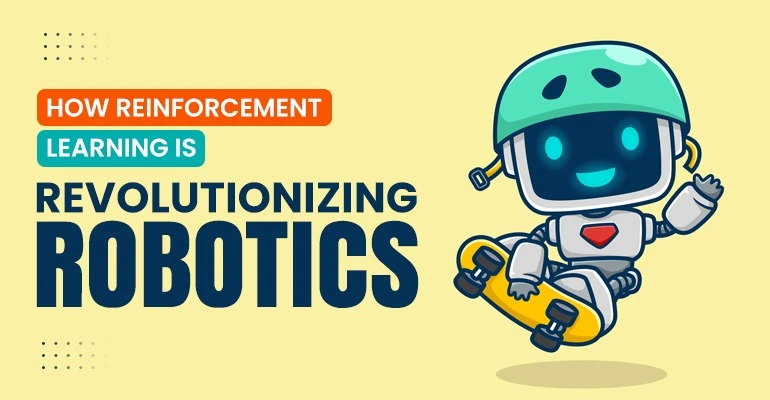How Reinforcement Learning is Revolutionizing Robotics
How Reinforcement Learning is Revolutionizing Robotics
Robotics has evolved from being a mechanical engineering discipline over the years to being the champion of artificial intelligence exhibits. Amongst whose several AI technologies will drive this rewrite, the one technique stands above all. Reinforcement Learning (RL) significantly changes the game. People learn through trial and error and the same is true for a robot by RL, this permits learning from experiences and then refinement of performance. Now that we know this, let us delve into the actual application of RL in robotics, that is, from simple automation to making robots solve real and unstructured problems.
What is Reinforcement Learning?
Reinforcement Learning in its core is an AI method in which an agent-let’s say, a robot- learns its skills based on interactions done with the environment. It rewards or punishes the agent and that is supposed to make it carry on the task better in the new series of repetitions. Unlike traditionally prescribed programming, which makes explicit every action to code, RL leaves robots to devise their fittest modes of acting on the situation.
Basic Applications of RL in Robotics
- Robotic manipulation
Robots are drive through precision manufacturing and logistics in order to do challenging tasks in handling objects. RL gives them ability to perform complex manipulation tasks such as picking fragile items, assembling components or even folding clothes. Then, those robots can then adapt to changes in the environment by encountering variations in shapes or encountering unexpected obstacles. They are adaptive in a rather more significant way than traditional robots of their similar sort.
- Autonomous Navigation
RL and adapting to the dynamism of the environments make robots move autonomously with a greater efficiency than before. These include warehouse robots that can shrink from collisions into tight-affordances when delivering their packages on demand. Even the very busy streets are passable by the self-driven cars as after some practice in RL, they learn routes much faster than ever before in the creation of new demand.
- Humanoids Robots
All the basic functions could be enhanced with humanoid robots aiming to mimic human behaviors, from walking and running unto impressing people with intricate tricks. RL is the missing link by which these robots would learn balancing and walking on rough floors or would even find the courage to change terrain a bit. This maximalizes them for their deployment in search and rescue, geriatric care, and even travel to outer space.
- Robotic-Surgery
In health care, precision is everything. Reinforcement Learning adds its perfection in the kind of surgical robots that enable most of them to see, learn and refine their surgical process automatically. These surgical robots perform minimal invasive surgeries with accuracy higher than that of most physicians, reducing the time of recovery and increasing the chances of patient survival.
- Learning through simulation
Regarded as one of the biggest things that RL has introduced for robot research is the training of robots within a simulated environment; before it goes into a warehouse or out onto the factory floor, it could experience many thousands of scenarios in a virtual space. This expedites learning but also diminishes risks that accompany real-world testing.
Emerging Trends in RL-Driven Robotics
Multi-Agent Reinforcement Learning
Multi-Agent Reinforcement Learning works for robots to work together, learn the benefit of collaboration and communication, and work for shared goals. The technology is advantageous for robotic applications like search-and-rescue missions or large-scale logistics operations.
Personalized Learning for Household Robots
RL has allowed robots in households to beef up their capacity in recalling their owners’ tastes and behavior. Just consider examples of household robots learning their job by either mapping out a customer visitation space or rooming in a kitchen with its cooking style-altering as per customer preferred flavors.
Robots in Agriculture
RL will allow many farming machines to converge in activities towards planting, watering, and harvesting. A robot with the right software is capable of learning about ripe plant-crops, knowing and avoiding the harvest of existing plants, and thus substantially increasing production yields.
Challenges and Road Ahead
While Reinforcement Learning offers massive scope, it brings with it a few hitches. One of the disadvantages such learning mode has in store is that it takes pretty much time to go about the whole process while simulated training almost leaves the robot incapable of adapting perfectly to the real-world conditions. Moreover, concerns are rendered as to safety and ethical use of RL-driven robots.
These disadvantages, however, betray the great promise in the future. Increases in computational power, better algorithms, and quality simulation tools have been swift in eclipsing these challenges. Over the next years, robots powered by RL are expected to flex themselves almost equally as potent in industries like healthcare, transportation, and environmental preservation.
Conclusion
It is not just about making robots better; it is about re-defining their abilities and what can be possible. Reinforcement learning inculcates the capability in the robots to learn, adjust, and improve them. This will help them be great partners for our daily and professional chores in the near future.
We are shaping individuals for harvesting the boon of AI at SkillzRevo throughout this exciting era of AI and robotics. Mastery in our specialization on AI and machine learning amounts to letting the learners adept with technologies occurring due to Reinforcement Learning. Let’s create the future of robotics today; begin your journey along with us.








